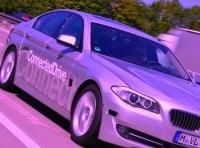
The British Government today passed legislation banning all human-driven motor vehicles from highways, effective one year from today. The move has been widely welcomed.
The loss of life due to motor accidents has hit an all-time high of almost 1.3 million deaths world-wide per annum.
Statistics show that human drivers are responsible for over 90% of all fatalities and although 70% of European motor vehicles today have automatic systems that permit driverless operation, only about half of drivers are using them.
All over Europe, there is a boom in ‘driving ranges’ where people who crave the adrenaline rush of driving a high performance car themselves can go for a spin in their favourite vehicle. Safe, exhilarating and expensive!
This new legislation has massive implications for the future of public transportation. With similar trends in air travel, governments will be forced to consider the integration of these new small networked systems (driverless cars and pilotless planes) into their largely centralized solutions inherited from the Victorian era.
ANALYSIS >> SYNTHESIS: How this scenario came to be
In the year 2000, more than 80 percent of all first-world workers went to work in a private car; 56 percent of the driving in America is now done in congested traffic. More than a million people are killed each year in car-related accidents. There has to be a better way.
2000-04: Cars go digital
New in-car technologies have moved from focusing on entertainment to safety and navigation. Radar installations become commonplace in prestige cars and shrill beeps to warn drivers of proximity of obstacles have replaced bumper-bashings. Active navigation systems are no longer the exception.
Technology is targeting increased engine efficiency and performance – particularly in view of increasingly stringent emission regulations. Safety systems, such as airbags, vehicle stability control and power steering, continue to evolve, offering greater comfort and more competitive cost/performance. Some critical functions such as braking are already dependent on digital technologies.
For the driver and passenger the car is soaked in ‘infotainment’ – a multimedia communications and navigation center, with a strong focus on minimal driver distraction and the growing need for creature comforts and convenience features such as specialized light modules and smart seats.
An Infineon Technologies press release states: “The vehicle is being transformed into a networked ‘ecosystem’ that enables new levels of convenience, comfort, integration, connectivity, safety and economy for car drivers. The future value of a vehicle will be the fine balance and seamless interplay across diverse components and solutions. And electronics, especially semiconductors, are the glue that puts the automotive ecosystem together”.
Still, the automotive industry takes one to three years to deploy new technology – the computer indystry takes less than six months. As technologies are increasingly sourced through active partnerships with technology firms, car makers’ time-to-market is set to decrease rapidly.
2006: A common navigation architecture for planes and cars is announced
NASA extends their navigation architecture for commercial and private aircraft, to encompass private cars and trucks.
A consortium of US, European and Japanese car companies announce that they will build all future cars to tie in to this newly proposed architecture. Within two years all cars produced by the consortium (which represents 70% of the world’s car production capacity) will include a common navigation and control architecture (NACA) that will ensure that no cars require drivers to operate them – and all of this on today’s standard roads – without any changes to the road infrastructure.
2008: First public trials
NACA and NASA join up to operate the first test site on public roads. Ireland has been selected to test the system and Dublin is to be the first pilot city.
Publicity surrounding the success of these trials finally puts to rest the idea of driverless cars needing road sensors and an expensive fixed infrastructure to be successful. results now show that all the technology can be distributed into each car and, coupled with a global navigation system, can provide safety and security for passengers way beyond the most ambitious expectations.
2009: Cars and mobile networks integrated
Motor vehicles are now also able to communicate with one another using wireless/mobile networks. Route optimisation and prioritisation happens automatically as cars communicate with one another and share information about where they are going, the time they have to be there and the importance of the passengers. Alternative routes are calculated on a continuous basis to optimise the outcome for all travellers.
Two billion people are now connected via global mobile phone networks and these are becoming increasingly integrated into what is being called a “navigation internet”. NASA’s NACA, the global GPS systems and mobile networks are now being interconnected to provide unprecedented fail-safe backup.
2018: Human drivers banned from highways
The british government’s announcement is really a pre-cursor to banning human drivers from all roads.
Warning: Hazardous thinking at work
Despite appearances to the contrary, Futureworld cannot and does not predict the future. Our Mindbullets scenarios are fictitious and designed purely to explore possible futures, challenge and stimulate strategic thinking. Use these at your own risk. Any reference to actual people, entities or events is entirely allegorical. Copyright Futureworld International Limited. Reproduction or distribution permitted only with recognition of Copyright and the inclusion of this disclaimer.
